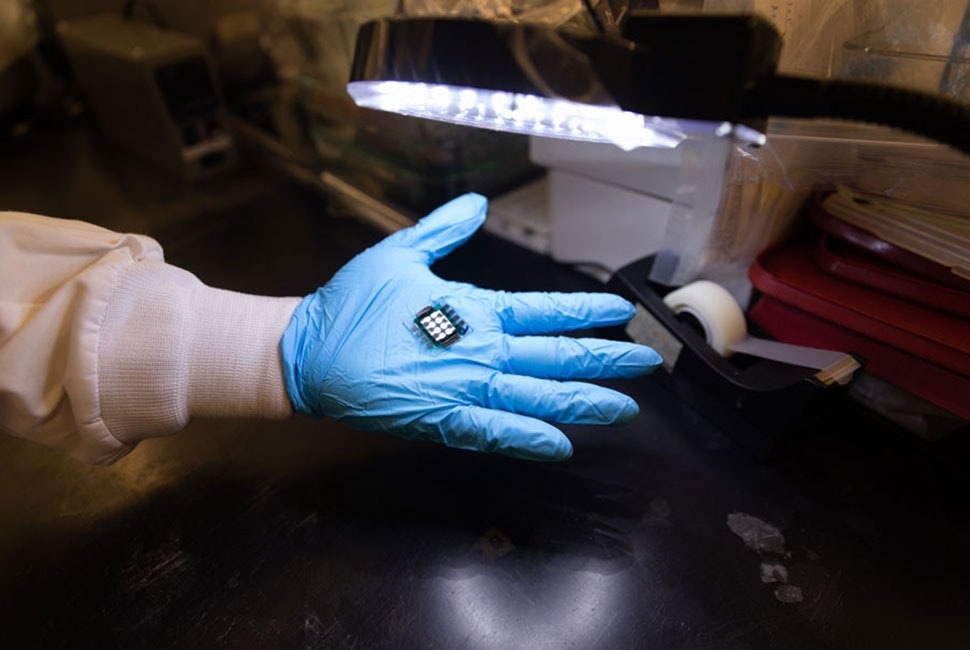Northwestern University researchers have once again elevated the benchmarks for perovskite solar cells, achieving new efficiency records through a groundbreaking development in the emerging technology.

Image Credit: Northwestern University.
Their findings, detailed in the journal Science on November 17, unveil a dual-molecule solution to combat efficiency losses during the conversion of sunlight into energy.
This innovative approach involves incorporating two molecules: the first addresses surface recombination, minimizing electron loss caused by defects (such as missing atoms on the surface), while the second molecule disrupts recombination at the interface between layers. This strategic integration led to an NREL-certified efficiency of 25.1%, surpassing earlier approaches that reached efficiencies of just 24.09%.
Perovskite solar technology is moving fast, and the emphasis of research and development is shifting from the bulk absorber to the interfaces. This is the critical point to further improve efficiency and stability and bring us closer to this promising route to ever-more-efficient solar harvesting.
Ted Sargent, Professor, Northwestern University
Sargent serves as the Co-Executive Director of the Paula M. Trienens Institute for Sustainability and Energy, previously known as ISEN. He is a versatile researcher specializing in materials chemistry and energy systems, holding positions in the Department of chemistry within the Weinberg College of Arts and Sciences, as well as in the Department of electrical and computer engineering in the McCormick School of Engineering.
Traditional solar cells are constructed from high-purity silicon wafers, a production-intensive material with limitations in absorbing only a specific range of the solar spectrum.
Perovskite materials offer the flexibility to adjust their size and composition, enabling the "tuning" of absorbed light wavelengths. This characteristic renders them a promising, potentially cost-effective, and high-efficiency emerging tandem technology.
Historically, the efficiency of perovskite solar cells has been hindered by their inherent instability. However, recent breakthroughs from Sargent's lab and other research groups have propelled perovskite solar cell efficiency into a range comparable to what can be achieved with silicon.
In this current research, the team diverted their attention from enhancing sunlight absorption to addressing the challenge of preserving and capturing generated electrons, aiming to boost efficiency. When the perovskite layer interfaces with the electron transport layer in the cell, electrons transfer between them. However, there is a possibility for electrons to revert outward and combine, or "recombine," with holes present on the perovskite layer.
“Recombination at the interface is complex. It’s very difficult to use one type of molecule to address complex recombination and retain electrons, so we considered what combination of molecules we could use to more comprehensively solve the problem,” notes First Author Cheng Liu, a Postdoctoral Student in the Sargent lab, which is co-supervised by the Charles E. and Emma H. Morrison Professor of Chemistry Mercouri Kanatzidis.
Previous research by Sargent's team highlighted the effectiveness of one molecule, PDAI2, in mitigating interface recombination. Their subsequent objective was to identify a molecule capable of addressing surface defects, thus preventing electrons from combining with these defects.
Through a quest to understand how PDAI2 could collaborate with a secondary molecule, the team focused on sulfur. This element has the potential to substitute carbon groups—traditionally ineffective in impeding electron movement—by covering vacant atoms and suppressing recombination.
In addressing the core inefficiencies found in inverted perovskite solar cells, which are predominantly due to nonradiative recombination losses, a new standard in solar cell efficiency is being set. This is a prime illustration of how the field of advanced materials chemistry can significantly enhance the energy conversion efficiency and longevity of emerging perovskite photovoltaic technologies.
Mercouri Kanatzidis, Professor, Northwestern University
Kanatzidis holds a prominent position as an authority in materials chemistry and sustainable energy solutions. He holds dual appointments in the Department of chemistry within Weinberg and the Department of materials science and engineering in McCormick.
“We are excited that our bimolecular strategy shows applicability to a range of perovskite compositions, including those that are promising for tandem solar cells,” noted Bin Chen, Research Assistant Professor of Chemistry and a Co-Author on the paper.
In a recent publication in Nature, the group introduced a substrate coating designed to enhance the cell's functionality at elevated temperatures and prolong its lifespan. According to Liu, this solution can complement the discoveries outlined in the Science paper.
The team anticipates that their research will inspire the broader scientific community to advance this field further. Simultaneously, they plan to conduct follow-up studies to build upon their current findings.
We have to use a more flexible strategy to solve the complex interface problem. We can’t only use one kind of molecule, as people previously did. We use two molecules to solve two kinds of recombination, but we are sure there’s more kinds of defect-related recombination at the interface. We need to try to use more molecules to come together and make sure all molecules work together without destroying each other’s functions.
Cheng Liu, Study First Author and Postdoctoral Student, Northwestern University
Journal Reference
Liu, C., et al. (2023). Bimolecularly passivated interface enables efficient and stable inverted perovskite solar cells. Science. doi.org/10.1126/science.adk1633.